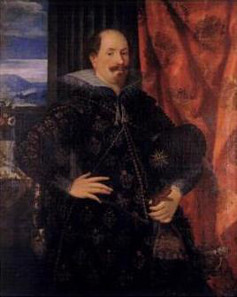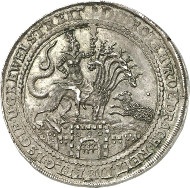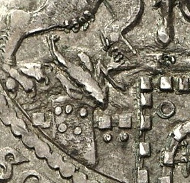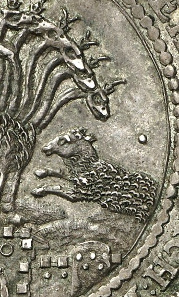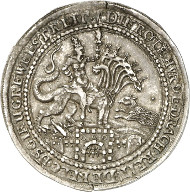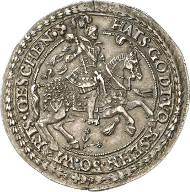Little ink has been spilled on the era between the Peace of Augsburg and the Thirty Years’ War. Perhaps the historians consider this period of time, with its economic, cultural and artistic blossom, not thrilling enough. Numismatics, on the other hand, provides marvelous testimonies to a pre-war society that was shaped by religion but acted rather broad-minded.
Admittedly, he really was somewhat out of the ordinary, that Ernst of Holstein-Schaumburg, youngest son of Count Otto IV of Schaumburg. Born in Bückeburg in 1569, he had no chance of ever reigning. Hence, his father did the same as many aristocrats back then: he put his son to school, so that he would be educated, in order to make his living as civil servant of a rich and powerful prince.
Ernst first went to the Latin school in Stadthagen, then – at the of 15 – to university, and afterwards he made the Grand Tour through Italy. When he was on his way he made sure of paying the (Catholic) emperor a visit. After all, the emperor was the first choice for any nobleman as employer.
Count Ernst of Holstein-Schaumburg (1569-1622), painting by Hans Rottenhammer, 1612. Source: Wikicommons.
That prudent plan became obsolete since not only every brother of Ernst died but their descendants as well. Thus, Ernst took over the counties Holstein and Schauenburg. He was one of the educated rulers of the empire since he had received a better training than most of his fellow aristocrats. Ernst became a patron of the arts. He founded a university, entrusted the most influential artists of his era with building a lavish seat of government and acted as munificent patron. He supported the Protestant theologian and historian Cyriacus Spangenberg as well as the alchemist Michael Maier.
Ernst of Holstein-Schauenburg’s court developed into a gathering place for the people of culture. Although the count was a convinced Protestant, Catholics were welcomed all the same. Ernst worked together with the Catholic emperor splendidly, and acquired from him – after the Thirty Years’ War had already broken out – the title of prince giving him a loan of 100,000 gulden in return.
That fact clearly reveals that the conflict between the emperor and the count palatine about Bohemia at the beginning of the Thirty Years’ War actually wasn’t considered by all parties involved as religious war. Although Protestants, members of the Reformed Church and Catholics disputed fiercely the Theologian details of the Imitation of Christ, the erudite ones amongst them did so in the confidence that, at the end of time, God would reveal to them the way in which he wanted to be venerated. Exactly that attitude is reflected in an enigmatic object that became known as Biblical thaler. Between 1618 and 1620 and on behalf of Ernst of Holstein-Schauenburg, mint master Christoph Feistell von Altona had created a medal with the weight of a thaler and a 1/2 thaler, to be offered for sale in the upcoming auction Künker 244 on 6th February 2014.
Ernst of Holstein-Schaumburg, 1601-1622. Medal with the weight of a thaler. Lange 837. From auction sale Künker 244 (6th February 2014), no. 315. Of greatest rarity. Extremely fine. Estimate: 25,000 euros.
The Whore of Babylon is depicted on its obverse. The biblical passage in the Apocalypse of John, which tells of the terrifying symbol of a world ruled by the devil, was well-known to every Theologian in the 16th century: “And I saw a woman sit upon a scarlet colored beast, full of names of blasphemy, having seven heads and ten horns. And the woman was arrayed in purple and scarlet color, and decked with gold and precious stones and pearls, having a golden cup in her hand full of abominations and filthiness of her fornication: and upon her forehead was a name written, Mystery, Babylon the Great, The Mother of Harlots and Abominations of the Earth. And I saw the woman drunken with the blood of the saints, and with the blood of the martyrs of Jesus.” The power that horrifying creature possesses is further specified in the inscription written in early modern High German, and it translates as: the red whore the dragon rides, the cup of poison and abomination [she] carries.
Detailed view of the very medal.
At her feet, the weapons of evil are shown: a strange hybrid creature composed of locust and scorpion – it is clearly visible that the die cutter has combined the stinger of the scorpion with the strong legs of the locust. These animals bring the trombone in order to further intensify the tortures of the Christians: “And the fifth angel sounded. And he opened the bottomless pit. And there came out of the smoke locusts upon the earth: and unto them was given power, as the scorpions of the earth have power. And it was commanded them that they should not hurt the grass of the earth, neither any green thing, neither any tree; but only those men which have not the seal of God in their foreheads.”
Detailed view of the very medal.
While the early Christians believed that text, which was written during the final years of Domitian’s reign, to be referring to the emperor and the imperial cult, the followers of Luther and Calvin identified the woman clad in purple and scarlet color as symbol of the flamboyant Catholic Church. Her war against the savior of the pious would be inevitable. In the end, however, good will prevail, epitomized by the white lamb: “These (the powers represented in the beast with the seven heads) shall make war with the Lamb, and the Lamb shall overcome them: for he is Lord of lords, and King of kings: and they that are with him are called, and chosen, and faithful.”
Ernst of Holstein-Schaumburg, 1601-1622. Medal with the weight of a 1/2 thaler. Lange 838. From auction sale Künker 244 (6th February 2014), no. 316. Of greatest rarity. Extremely fine. Estimate: 25,000 euros.
Thus, the innocent white lamb approaches from the right side to attack the Whore of Babylon. Its victory is predetermined, as the inscription on the reverse of the medal with the depiction of the count as armed knight puts it plainly: as God has predetermined, so it will happen.
Its belligerent appearance notwithstanding, this medal is an advised demand for temperance. The Catholic Church’s damnability is addressed and stated as a fact but – according to the inscription on the reverse – it is not up to man but to God to decide on the battle against ‘evil’. Ernst very likely sent his medals, together with an accompanying letter as “Verehrung” (= reverence) – as a gift was called back then – to all decision makers he was acquainted to in order to air his opinions.
With this policy, Ernst managed to stay a faithful Protestant and a loyal subject of the emperor at the same time. As such, he died on 17th January 1622. His successor was Jobst Hermann of Holstein-Schaumburg, a Catholic who navigated his Protestant territories through the turmoil of the Thirty Years’ War with great care. His successor, a Calvinist, likewise preserved the faith of his subjects until, on 14th November 1640, i.e. at a time when the Thirty Years’ War wasn’t over yet, the Schaumburg dynasty ended with him.




